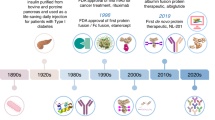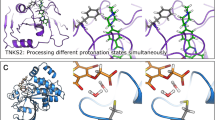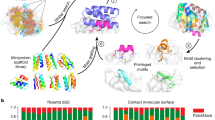Abstract
Functional genomics and proteomics are identifying many potential drug targets for novel therapeutic proteins, and both rational and combinatorial protein engineering methods are available for creating drug candidates. A central challenge is the definition of the most appropriate design criteria, which will benefit critically from computational kinetic models that incorporate integration from the molecular level to the whole systems level. Interpretation of these processes will require mathematical models that are refined in combination with relevant data derived from quantitative assays, to correctly set biophysical objectives for protein design.
This is a preview of subscription content, access via your institution
Access options
Subscribe to this journal
Receive 12 print issues and online access
$209.00 per year
only $17.42 per issue
Buy this article
- Purchase on Springer Link
- Instant access to full article PDF
Prices may be subject to local taxes which are calculated during checkout

Bob Crimi
Similar content being viewed by others
References
Horrobin, D.F. Realism in drug discovery-could Cassandra be right? Nat. Biotechnol. 19, 1099–1100 (2001).
Rees, J. Complex disease and the new clinical sciences. Science 296, 698–700 (2002).
Butte, A. The use and analysis of microarray data. Nat. Rev. Drug Discov. 1, 951–960 (2002).
Wiley, H.S., Shvartsman, S.Y. & Lauffenburger, D.A. Computational modeling of the EGF-receptor system: a paradigm for systems biology. Trends Cell Biol. 13, 43–50 (2003).
Mendelsohn, J. & Baselga, J. Status of epidermal growth factor receptor antagonists in the biology and treatment of cancer. J. Clin. Oncol. 21, 2787–2799 (2003).
Lauffenburger, D.A. & Linderman, J.J. Receptors: Models for Binding, Trafficking, and Signaling. (Oxford University Press, Oxford, UK 1993).
Reddy, C.C., Niyogi, S.K., Wells, A., Wiley, H.S. & Lauffenburger, D.A. Engineering epidermal growth factor for enhanced mitogenic potency. Nat. Biotechnol. 14, 1696–1699 (1996).
Sarkar, C.A. et al. Rational cytokine design for increased lifetime and enhanced potency using pH-activated histidine switching. Nat. Biotechnol. 20, 908–913 (2002).
Stroud, R.M. & Wells, J.A. Mechanistic diversity of cytokine receptor signaling across cell membranes. Sci. STKE 231, RE7 (2004).
Brekke, O.H. & Sandlie, I. Therapeutic antibodies for human diseases at the dawn of the twenty-first century. Nat. Rev. Drug Discov. 2, 52–62 (2003).
Goffe, B. & Cather, J.C. Etanercept: an overview. J. Am. Acad. Dermatol. 49, S105–S111 (2003).
Holash, J. et al. VEGF-Trap: a VEGF blocker with potent antitumor effects. Proc. Natl. Acad. Sci. USA 99, 11393–11398 (2002).
Pearce, K.H. Jr., Cunningham, B.C., Fuh, G., Teeri, T. & Wells, J.A. Growth hormone binding affinity for its receptor surpasses the requirements for cellular activity. Biochemistry 38, 81–89 (1999).
Haugh, J.M. Mathematical model of human growth hormone (hGH)-stimulated cell proliferation explains the efficacy of hgh variants as receptor agonists or antagonists. Biotechnol. Prog. 20, 1337–1344 (2004).
Foote, J. & Eisen, H.N. Kinetic and affinity limits on antibodies produced during immune responses. Proc. Natl. Acad. Sci. USA 92, 1254–1256 (1995).
Sarkar, C.A. & Lauffenburger, D.A. Cell-level pharmacokinetic model of granulocyte colony-stimulating factor: implications for ligand lifetime and potency in vivo. Mol. Pharmacol. 63, 147–158 (2003).
Lauffenburger, D.A., Fallon, E.M. & Haugh, J.M. Scratching the (cell) surface: cytokine engineering for improved ligand/receptor trafficking dynamics. Chem. Biol. 5, R257–R263 (1998).
Fallon, E.M. & Lauffenburger, D.A. Computational model for effects of ligand/receptor binding properties on interleukin-2 trafficking dynamics and T cell proliferation response. Biotechnol. Prog. 16, 905–916 (2000).
Smith, K.A. Cell growth signal transduction is quantal. Ann. NY Acad. Sci. 766, 263–271 (1995).
Li, Q.J. et al. CD4 enhances T-cell sensitivity to antigen by coordinating Lck accumulation at the immunological synapse. Nat. Immunol. 5, 791–799 (2004).
Goldbeter, A. & Koshland, D.E. Jr. An amplified sensitivity arising from covalent modification in biological systems. Proc. Natl. Acad. Sci. USA 78, 6840–6844 (1981).
Tyson, J.J., Chen, K.C. & Novak, B. Sniffers, buzzers, toggles and blinkers: dynamics of regulatory and signaling pathways in the cell. Curr. Opin. Cell Biol. 15, 221–231 (2003).
Schoeberl, B., Eichler-Jonsson, C., Gilles, E.D. & Muller, G. Computational modeling of the dynamics of the MAP kinase cascade activated by surface and internalized EGF receptors. Nat. Biotechnol. 20, 370–375 (2002).
Gardner, T.S., Cantor, C.R. & Collins, J.J. Construction of a genetic toggle switch in Escherichia coli. Nature 403, 339–342 (2000).
Angeli, D., Ferrell, J.E. Jr. & Sontag, E.D. Detection of multistability, bifurcations, and hysteresis in a large class of biological positive-feedback systems. Proc. Natl. Acad. Sci. USA 101, 1822–1827 (2004).
Osbourn, J., Jermutus, L. & Duncan, A. Current methods for the generation of human antibodies for the treatment of autoimmune diseases. Drug Discov. Today 8, 845–851 (2003).
Sanna, P.P., Ramiro-Ibanez, F. & De Logu, A. Synergistic interactions of antibodies in rate of virus neutralization. Virology 270, 386–396 (2000).
Vasserot, A.P. et al. Optimization of protein therapeutics by directed evolution. Drug Discov. Today 8, 118–126 (2003).
Forsten, K.E. & Lauffenburger, D.A. Interrupting autocrine ligand-receptor binding: comparison between receptor blockers and ligand decoys. Biophys. J. 63, 857–861 (1992).
Jain, R.K. Transport of molecules, particles, and cells in solid tumors. Annu. Rev. Biomed. Eng. 1, 241–263 (1999).
Flynn, A.A. et al. A model-based approach for the optimization of radioimmunotherapy through antibody design and radionuclide selection. Cancer 94, 1249–1257 (2002).
Adams, G.P. et al. High affinity restricts the localization and tumor penetration of single-chain fv antibody molecules. Cancer Res. 61, 4750–4755 (2001).
Graff, C.P. & Wittrup, K.D. Theoretical analysis of antibody targeting of tumor spheroids: importance of dosage for penetration, and affinity for retention. Cancer Res. 63, 1288–1296 (2003).
Fujimori, K., Covell, D.G., Fletcher, J.E. & Weinstein, J.N. A modeling analysis of monoclonal antibody percolation through tumors: a binding-site barrier. J. Nucl. Med. 31, 1191–1198 (1990).
Egrie, J.C., Dwyer, E., Browne, J.K., Hitz, A. & Lykos, M.A. Darbepoetin alfa has a longer circulating half-life and greater in vivo potency than recombinant human erythropoietin. Exp. Hematol. 31, 290–299 (2003).
Chang, T.W. The pharmacological basis of anti-IgE therapy. Nat. Biotechnol. 18, 157–162 (2000).
Lu, Z.Y. et al. High amounts of circulating interleukin (IL)-6 in the form of monomeric immune complexes during anti-IL-6 therapy. Towards a new methodology for measuring overall cytokine production in human in vivo. Eur. J. Immunol. 22, 2819–2824 (1992).
Montero-Julian, F.A., Klein, B., Gautherot, E. & Brailly, H. Pharmacokinetic study of anti-interleukin-6 (IL-6) therapy with monoclonal antibodies: enhancement of IL-6 clearance by cocktails of anti-IL-6 antibodies. Blood 85, 917–924 (1995).
Harris, J.M. & Chess, R.B. Effect of pegylation on pharmaceuticals. Nat. Rev. Drug Discov. 2, 214–221 (2003).
Ashkenazi, A. & Chamow, S.M. Immunoadhesins as research tools and therapeutic agents. Curr. Opin. Immunol. 9, 195–200 (1997).
Dennis, M.S. et al. Albumin binding as a general strategy for improving the pharmacokinetics of proteins. J. Biol. Chem. 277, 35035–35043 (2002).
Rao, B.M., Driver, I., Lauffenburger, D.A. & Wittrup, K.D. IL-2 variants engineered for increased IL-2R affinity exhibit increased potency arising from a cell surface ligand reservoir effect. Mol. Pharmacol. 66, 864–869 (2004).
Dubois, S., Mariner, J., Waldmann, T.A. & Tagaya, Y. IL-15R alpha recycles and presents IL-15 In trans to neighboring cells. Immunity 17, 537–547 (2002).
Giovannoni, G. Strategies to treat and prevent the development of neutralizing anti-interferon-beta antibodies. Neurology 61, S13–S17 (2003).
Rosenberg, A.S. Immunogenicity of biological therapeutics: a hierarchy of concerns. Dev. Biol. (Basel) 112, 15–21 (2003).
Schellekens, H. Bioequivalence and the immunogenicity of biopharmaceuticals. Nat. Rev. Drug Discov. 1, 457–462 (2002).
Patten, P.A. & Schellekens, H. The immunogenicity of biopharmaceuticals. Lessons learned and consequences for protein drug development. Dev. Biol. (Basel) 112, 81–97 (2003).
Bander, N.H. et al. Targeted systemic therapy of prostate cancer with a monoclonal antibody to prostate-specific membrane antigen. Semin. Oncol. 30, 667–676 (2003).
Wittrup, K.D. Protein engineering by cell-surface display. Curr. Opin. Biotechnol. 12, 395–399 (2001).
Marshall, S.A., Lazar, G.A., Chirino, A.J. & Desjarlais, J.R. Rational design and engineering of therapeutic proteins. Drug Discov. Today 8, 212–221 (2003).
Lazar, G.A., Marshall, S.A., Plecs, J.J., Mayo, S.L. & Desjarlais, J.R. Designing proteins for therapeutic applications. Curr. Opin. Struct. Biol. 13, 513–518 (2003).
Chakraborty, A.K., Dustin, M.L. & Shaw, A.S. In silico models for cellular and molecular immunology: successes, promises and challenges. Nat. Immunol. 4, 933–936 (2003).
Perelson, A.S. Modelling viral and immune system dynamics. Nat. Rev. Immunol. 2, 28–36 (2002).
Bialek, W. & Botstein, D. Introductory science and mathematics education for 21st-Century biologists. Science 303, 788–790 (2004).
Griffith, L.G. & Grodzinsky, A.J. Advances in biomedical engineering. J. Am. Med. Assoc. 285, 556–561 (2001).
Grossmann, M., Leitolf, H., Weintraub, B.D. & Szkudlinski, M.W. A rational design strategy for protein hormone superagonists. Nat. Biotechnol. 16, 871–875 (1998).
Kortemme, T. & Baker, D. A simple physical model for binding energy hot spots in protein-protein complexes. Proc. Natl. Acad. Sci. USA 99, 14116–14121 (2002).
Steed, P.M. et al. Inactivation of TNF signaling by rationally designed dominant-negative TNF variants. Science 301, 1895–1898 (2003).
Acknowledgements
The authors are grateful for financial support from the National Science Foundation Biotechnology Process Engineering Center and National Institutes of Health grant CA96504. We are grateful for insightful comments on the manuscript by Jennifer Cochran, Jim Huston, Bob Kamen, Dasa Lipovsek, Dev Sidhu and Jeff Way, and the anonymous referees.
Author information
Authors and Affiliations
Corresponding author
Ethics declarations
Competing interests
The authors declare no competing financial interests.
Rights and permissions
About this article
Cite this article
Rao, B., Lauffenburger, D. & Wittrup, K. Integrating cell-level kinetic modeling into the design of engineered protein therapeutics. Nat Biotechnol 23, 191–194 (2005). https://doi.org/10.1038/nbt1064
Published:
Issue Date:
DOI: https://doi.org/10.1038/nbt1064
This article is cited by
-
Selection and characterization of the novel anti-human PD-1 FV78 antibody from a targeted epitope mammalian cell-displayed antibody library
Cellular & Molecular Immunology (2018)
-
Systems biology driving drug development: from design to the clinical testing of the anti-ErbB3 antibody seribantumab (MM-121)
npj Systems Biology and Applications (2017)
-
Pairwise comparison of 89Zr- and 124I-labeled cG250 based on positron emission tomography imaging and nonlinear immunokinetic modeling: in vivo carbonic anhydrase IX receptor binding and internalization in mouse xenografts of clear-cell renal cell carcinoma
European Journal of Nuclear Medicine and Molecular Imaging (2014)
-
Multiscale Models of Breast Cancer Progression
Annals of Biomedical Engineering (2012)
-
Predicting the F(ab)-mediated effect of monoclonal antibodies in vivo by combining cell-level kinetic and pharmacokinetic modelling
Journal of Pharmacokinetics and Pharmacodynamics (2012)



